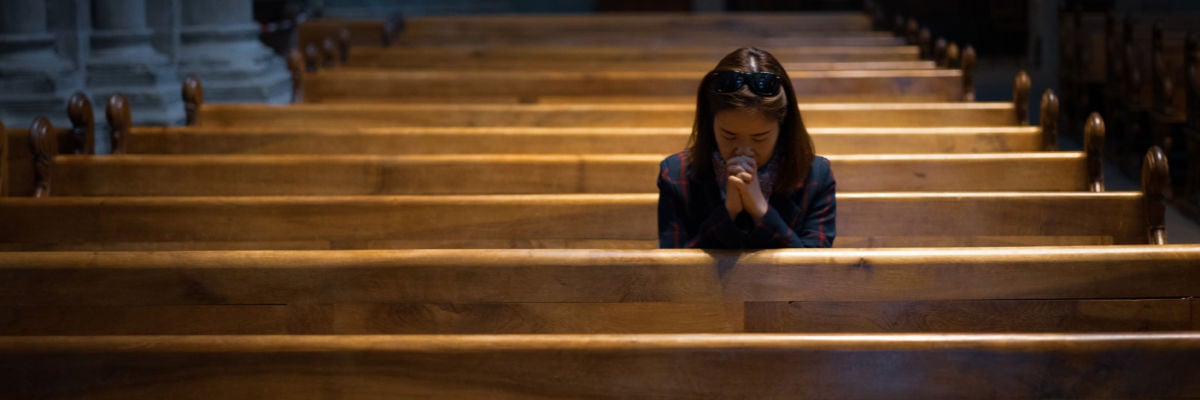
One sunny day, I received an anguished message from a distraught Catholic wife and mother whom I’ll call “Sarah.” Sarah and her children had been left devastated by her husband’s affair and subsequent abandonment of their marriage—but that is not what had her in tears this day.
Sarah told me she had been listening to Catholic radio when she heard a divorce and annulment “expert” treating the issue of those who “can’t move on” after spousal abandonment. The message was clear: if someone has moved on from his relationship with you, then there is something emotionally or mentally wrong with you unless you move on as well. It is “unhealthy,” you see, to stay true to a spouse who doesn’t want you anymore.
Sarah is what is called a stander—a spouse who stays faithful to her vows, even after abandonment, separation, or civil divorce (and even if the stander is the one who had to physically separate due to dangerous circumstances). These folks “stand” for their marriages, knowing that the sacrament of matrimony is permanent and indissoluble, with most hoping and praying for eventual redemption and reunion.
Sarah told me that day, through her tears, that this was not the first time she had been shamed and humiliated in this way by members of her own faith, and that it hurt almost as much as the initial betrayal.
My heart broke for the injustice of it. I assured Sarah that there was nothing wrong with her for keeping her marriage vows despite such a heavy cross. Quite the contrary: It is expected that a Christian would stand for her marriage, and Christ—the ultimate abandoned spouse—stands with her! Far from “unhealthy,” her stance is virtuous. She understood the immense and eternal implications of what the Church teaches about marriage, given to us by Christ himself: “a ratified and consummated marriage cannot be dissolved by any human power or for any reason other than death” (CCC 2382).
Because of my work, I soon began to hear from more women (and men) who had been condescended to or shamed by other Catholics for remaining faithful to their sacred promises. I started to understand that too many clergy, therapists, and other agents of the Church support the “moving on” from a marriage more than they support the marriage and the abandoned spouses who are keeping vigil for their “prodigals” through the practice of a lonely fidelity. Shockingly, I’ve even seen at least one judicial vicar scold the innocent, faithful spouse—not the abandoner—for setting a bad example by remaining faithful!
I became increasingly disturbed that the common narrative on lifelong fidelity, even among otherwise faithful Catholics, stands in contradiction to what we know it should be.
Although standers are essentially invisible in our Catholic world today, the Church desires the opposite. Consider statements by St. John Paul II in Familiaris Consortio that, far from being invisible, the standers should be witnesses for the Church. He laments those who are “caught up in a culture that rejects the indissolubility of marriage and openly mocks the commitment of spouses to fidelity” and reminds us that it is
proper to recognize the value of the witness of those spouses who, even when abandoned by their partner, with the strength of faith and of Christian hope have not entered a new union: these spouses too give an authentic witness to fidelity, of which the world today has a great need. For this reason they must be encouraged and helped by the pastors and the faithful of the Church (20).
I urge you to read all of section 83, which speaks of the “loneliness and difficulties” of standers and the need for the Church to give “much respect, solidarity, understanding and practical help, so that they can preserve their fidelity even in their difficult situation.” JPII speaks admiringly of “their example of fidelity and Christian consistency,” which “takes on particular value as a witness before the world and the Church.”
Can we reasonably say that we treat standers with this type of respect, giving them visibility as witnesses to all? I don’t think we can. Why not?
Perhaps standers make us uncomfortable because they remind us that real suffering and the cross are required to follow Jesus. The loneliness and hardships of fidelity after abandonment are real, and who wants to accept that people might have to live the rest of their lives without romance and companionship?
Or perhaps our perverse culture cannot comprehend the idea of long-term, even lifelong, abstention from sex that may be required of a stander. Because we can’t bear it, we turn the one who sacrifices into the one with the “problem,” to make ourselves feel better, to banish the fear that we, too, might be called to such a sacrifice one day.
In truth, fidelity and heroic virtue are desirable, and are within our grasp, but we need the support of our Christian community and the Church to help us. As Hilary Towers and I wrote, sexual continence after divorce and separation is not a sign of mental imbalance or oddity. Neither is it unrealistic for the average man and woman of goodwill, if they are given enthusiastic support by their families and their Church.
And as Hilary wrote elsewhere,
[divorced and separated] people today—especially ones who have been unjustly abandoned—have a unique and vital mission, if only the Church would support them unconditionally in it.
She continued, “God is calling many divorced spouses to keep their wedding bands on” as a witness to their children and a desperate world that “real love is possible only when we can choose to remain chaste—for as long as love’s demands require it.”
The mind of the Church is shown in the words of Pope Leo XIII, that grace and truth lie not in the “moving on,” but in the fidelity to even the most difficult marriage, with the unwavering help of the Church:
When, indeed, matters have come to such a pitch that it seems impossible for [spouses] to live together any longer, then the Church allows them to live apart . . . yet she never ceases to endeavor to bring about a reconciliation, and never despairs of doing so (Arcanum Divinae 41).
In other words, the Church permits the separation of spouses in cases of “grave mental or physical danger,” but with the hope and aim of reconciliation “in all cases” (see the Code of Canon Law 1153 §1-§2).
Now that we see our responsibility as the Church, truth demands that we turn around and go back to an authentic Christian understanding of “standing” for our marriages versus the now-reflexive “moving on” paradigm offered in our dioceses and parishes today. Such a reversal will take us back to fidelity to Christ, and back to the redemptive power of the Cross.
Today, we have annulment pamphlets, annulment workshops, and parish programs for the divorced or separated, which often facilitate the “moving on.” But what if, instead, we saw copious pamphlets and workshops for the healing of desperate marriages, and for real support of abandoned spouses? What if there were parish and diocesan ministries for the support of standers, as the Church has called for? (I’ve heard of only one, and it was disbanded.)
If the local and national Church made clear that “we will do whatever it takes to help save your marriage, and if you are abandoned, we will be your support as you witness Christ-like fidelity to the community”—what a beautiful expectation of matrimony would bloom in our churches!
And rediscovered support of standers would mean fewer Sarahs weeping to a stranger when the shaming by fellow Catholics compounds the betrayal of an abandoning spouse.



